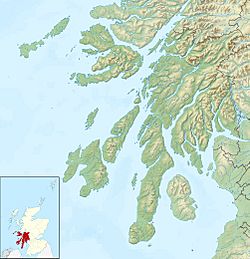Dunagoil facts for kids
| Location | Isle of Bute |
|---|---|
| Region | Scotland |
| Coordinates | 55°44′02″N 5°03′04″W / 55.734°N 5.051°W |
| Type | hill fort |
| Length | 300 feet |
| Width | 75 feet |
| History | |
| Material | wood and stone |
| Periods | Iron Age |
Dunagoil is an ancient fort on the beautiful Isle of Bute in Scotland. It's a special kind of hill fort from the Iron Age. What makes it unique is that parts of its walls were melted by intense heat! This is why it's called a "vitrified fort." Dunagoil sits on a high, rocky point overlooking a bay, which is also named after it. The name "Dunagoil" comes from the Gaelic words dún na gall, which mean "fort of the foreigners."
Contents
What is a Vitrified Fort?
A vitrified fort is a hill fort where the stone walls have been partly melted. This melting happens because of very high heat. The stones and rocks become like glass or slag. This process is called vitrification.
How Did Vitrification Happen?
Scientists are not completely sure how these forts became vitrified. One idea is that the forts were set on fire by attackers. The intense heat from burning wood and other materials could have melted the stone. Another idea is that the builders themselves used fire to strengthen the walls. They might have heated the stones to make them fuse together. This would have created a very strong, solid rampart.
Why is Vitrification Important?
Vitrification is important because it tells us about ancient building methods. It also shows how powerful fires could be in the past. These forts are a mystery that archaeologists are still trying to solve. They give us clues about life in the Iron Age.
Dunagoil: An Iron Age Hill Fort
Dunagoil was built during the Iron Age. This period in history was from about 800 BC to AD 100. People in the Iron Age used iron tools and weapons. They often lived in hill forts like Dunagoil. These forts were built on high ground for protection.
What Was a Hill Fort Used For?
Hill forts were important places for ancient communities. They served several purposes:
- Defense: They protected people from enemies. The high walls and location made them hard to attack.
- Homes: People lived inside the forts. They built houses and other structures there.
- Community Centers: Forts were places where people met. They could trade goods or hold important events.
- Status Symbols: Building a large fort showed the power of a community.
Dunagoil's Location and Size
Dunagoil is located on a volcanic headland. This means it's on a high, flat area formed by ancient volcanoes. This spot offers great views of the surrounding area. It was perfect for spotting enemies from far away. The fort is about 300 feet long and 75 feet wide. Its size shows it was a significant settlement.
Life in the Iron Age
The Iron Age was a time of change in Scotland. People started farming more. They also developed new skills like working with iron. Life was often challenging, but communities worked together.
Daily Life at Dunagoil
People living at Dunagoil would have spent their days farming, hunting, and fishing. They would have made their own clothes and tools. Life was closely tied to the land and the sea. The fort provided a safe place to live and store food.
What Can We Learn from Dunagoil?
Dunagoil helps us understand how people lived thousands of years ago. It shows their cleverness in building strong defenses. It also highlights the mysteries that still exist about ancient times. Visiting places like Dunagoil connects us to our past.


